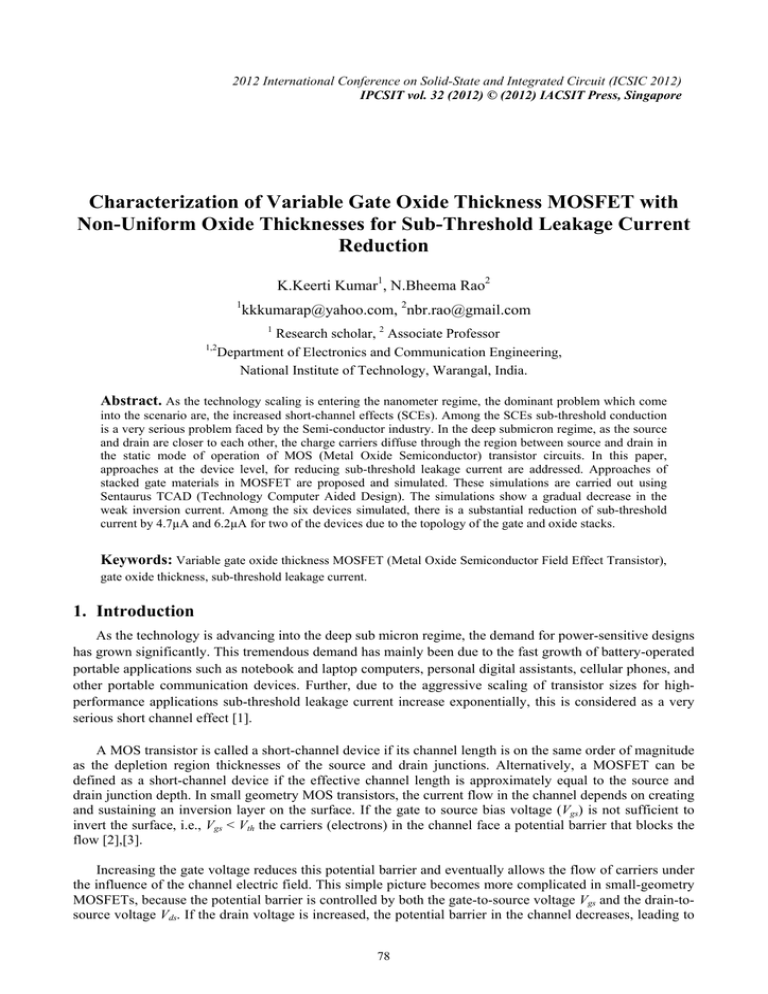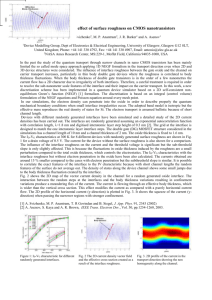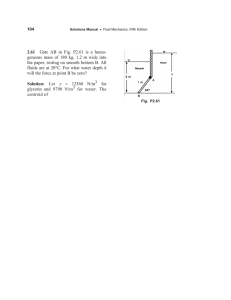Characterization of Variable Gate Oxide Thickness MOSFET with
advertisement

2012 International Conference on Solid-State and Integrated Circuit (ICSIC 2012) IPCSIT vol. 32 (2012) © (2012) IACSIT Press, Singapore Characterization of Variable Gate Oxide Thickness MOSFET with Non-Uniform Oxide Thicknesses for Sub-Threshold Leakage Current Reduction K.Keerti Kumar1, N.Bheema Rao2 1 kkkumarap@yahoo.com, 2nbr.rao@gmail.com 1 Research scholar, 2 Associate Professor 1,2 Department of Electronics and Communication Engineering, National Institute of Technology, Warangal, India. Abstract. As the technology scaling is entering the nanometer regime, the dominant problem which come into the scenario are, the increased short-channel effects (SCEs). Among the SCEs sub-threshold conduction is a very serious problem faced by the Semi-conductor industry. In the deep submicron regime, as the source and drain are closer to each other, the charge carriers diffuse through the region between source and drain in the static mode of operation of MOS (Metal Oxide Semiconductor) transistor circuits. In this paper, approaches at the device level, for reducing sub-threshold leakage current are addressed. Approaches of stacked gate materials in MOSFET are proposed and simulated. These simulations are carried out using Sentaurus TCAD (Technology Computer Aided Design). The simulations show a gradual decrease in the weak inversion current. Among the six devices simulated, there is a substantial reduction of sub-threshold current by 4.7µA and 6.2µA for two of the devices due to the topology of the gate and oxide stacks. Keywords: Variable gate oxide thickness MOSFET (Metal Oxide Semiconductor Field Effect Transistor), gate oxide thickness, sub-threshold leakage current. 1. Introduction As the technology is advancing into the deep sub micron regime, the demand for power-sensitive designs has grown significantly. This tremendous demand has mainly been due to the fast growth of battery-operated portable applications such as notebook and laptop computers, personal digital assistants, cellular phones, and other portable communication devices. Further, due to the aggressive scaling of transistor sizes for highperformance applications sub-threshold leakage current increase exponentially, this is considered as a very serious short channel effect [1]. A MOS transistor is called a short-channel device if its channel length is on the same order of magnitude as the depletion region thicknesses of the source and drain junctions. Alternatively, a MOSFET can be defined as a short-channel device if the effective channel length is approximately equal to the source and drain junction depth. In small geometry MOS transistors, the current flow in the channel depends on creating and sustaining an inversion layer on the surface. If the gate to source bias voltage (Vgs) is not sufficient to invert the surface, i.e., Vgs < Vth the carriers (electrons) in the channel face a potential barrier that blocks the flow [2],[3]. Increasing the gate voltage reduces this potential barrier and eventually allows the flow of carriers under the influence of the channel electric field. This simple picture becomes more complicated in small-geometry MOSFETs, because the potential barrier is controlled by both the gate-to-source voltage Vgs and the drain-tosource voltage Vds. If the drain voltage is increased, the potential barrier in the channel decreases, leading to 78 drain-induced barrier lowering (DIBL) [4],[5]. The reduction of the potential barrier eventually allows electron flow between the source and the drain, even if the gate-to-source voltage is lower than the threshold voltage (Vth). The channel current that flows under these conditions (Vgs < Vth) is called the weak inversion current or sub-threshold current. In MOS transistor digital circuits, the total power dissipation is divided into functional power and parasitical power and is given by equation (1). The functional power is the power required to just change the state capacitors charges of a digital circuit while processing the information i.e. in the active mode of operation of the circuit [6],[7]. Ptotal = Pfunctional+Pparasitical (1) The parasitical power is combination of leakage power and short-circuits power and is given by equation (2). The leakage power is the power which is dissipated and dominant when the circuit is idle. The shortcircuit power is the power which could be dissipated during state transitions without attributing to the actual changes of the internal states [6],[7]. Pparasitical=Pleakage+Pshort-circuit (2) Leakage power is combination of many other current components such as channel edge current, DIBL current and weak inversion current. The weak inversion currents increase exponentially under constant field scaling conditions due to down scaling of threshold voltage. Also the weak inversion current has an inverse dependency on gate oxide thickness. This can be clearly observed from the equation (3). As a result power dissipation caused by weak inversion current becomes dominant during standby periods, because functional and short-circuit power dissipation are non-existent during the standby periods [6],[7]. I sub = μ 0 ⎛ Vgs −Vth +ηVds Vt ⎜ e nVt ⎜ L ⎝ ε ox W t ox 2 −Vds ⎞⎛ ⎟⎜1 − e Vt ⎟⎜ ⎠⎝ ⎞ ⎟ ⎟ ⎠ (3) Where Isub is the sub-threshold current, W and L are the width and length of the transistor, μ 0 is the carrier mobility, Vt is the thermal width, η is the DIBL coefficient, n is the sub-threshold swing, Vds is the drain to source voltage, Vgs is the gate to source voltage, Vth is the threshold voltage, ε ox is the permittivity of the oxide, tox is the thickness of the oxide. A transistor level approach for reducing sub-threshold leakage current has been reported in [8]. In [8] thickness of the oxide has been varied uniformly. In this paper based on the Isub and tox dependency relation, different gate structure topologies are proposed to study the effect of variation of Isub for different non uniform tox combinations. All the possible combinations of the gate oxide thicknesses are considered and are shown in Fig.1a, Fig.2 to Fig. 6 respectively. Their Vgs vs Id characteristics are shown from Fig.7 to Fig.12 respectively. 2. Variable gate oxide thickness MOSFET Fig. 1: Variable gate oxide thickness MOSFET 79 A variable gate oxide thickness MOSFET is shown in Fig.1. It consists of stacked gate structure. The gate terminals are named as G1, G2 and G3. When the MOSFET is biased, the weak inversion region is formed for the voltage 0 < Vgs < Vth. In these conditions Id = Isub. When the gate G1 is considered, the operation is similar to a normal MOSFET, while the gate G2 terminal is considered the sub-threshold current is lowered to that of the current at G1 because the threshold voltage of the transistor is altered when the oxide thickness is increased. So the measured current is lower compared to the current measured at G1. When the gate G3 terminal is considered for the operation of the MOSFET, the sub-threshold current is still low compared to the sub-threshold currents at G1 and G2 terminals. The threshold voltage of the transistor increases in this case because the oxide thickness has been increased. So only less current flows between source and drain. 3. Approach for non-uniform oxide thicknesses in Variable Gate oxide thickness MOSFET In [8] thickness of the oxide has been varied uniformly. In this paper based on the Isub and tox dependency relation, different gate structure topologies are considered to study the effect of variation of Isub for different non uniform tox combinations. For all the devices i.e. Device 1, Device 2, Device 3, Device 4, Device 5, and Device 6 which are shown in Fig.1a, Fig.2 to Fig.6 respectively, the thinner gate terminal thickness is 10A0 (A0 is Angstrom unit which is one tenth of nano), thicker gate terminal thickness is 20A0 and the thickest gate terminal thickness is 30A0. The thickness of the oxide is 5A0. 110nm technology has been used for the simulations. The substrate is Silicon material, gate is poly crystalline silicon and the oxide is silicon dioxide (SiO2). The gate structures, Vgs vs Id characteristics and the sub-threshold leakage current (Isub) values are shown in the following table. Device Gate structure Vgs vs Id Characteristics Fig.1a :Device 1 Fig.7 : Device 1 characteristics Fig.2 :Device 2 Gate term inal Isub (µA) G1 39.5 G2 37.8 G3 37.4 G1 45 G2 40.2 G3 39 Fig.8 : Device 2 characteristics 80 Fig.3 :Device 3 Fig.4 :Device 4 Fig.5 :Device 5 Fig.9 : Device 3 characteristics G1 42 G2 37.8 G3 37.3 G1 45 G2 40 G3 38.8 G1 42 G2 40 G3 38.8 G1 39.5 G2 38.7 G3 37.3 Fig.10 : Device 4 characteristics Fig.11 : Device 5 characteristics Fig.12 : Device 6 characteristics Fig.6 :Device 6 4. Implementation and results The gate structure of Device 1 shown in Fig.1a is the combination of three gate over gate structures whose lower gate terminal thickness is 10A0, middle gate thickness is 20A0 and the top gate thickness is 30A0. If the below terminal i.e. gate G1 is considered for biasing the thickness of the oxide seen is 5A0. If the middle terminal i.e. gate G2 is considered for biasing, the effective oxide thickness seen is combination of the thicknesses of the bottom oxide layer, thickness of gate G1 and thickness of the middle oxide layer. This effective thickness is considered to be the total thickness of the oxide at this terminal. Hence the total oxide thickness observed at gate G2 is 20A0. Now if the top terminal i.e. gate G3 is considered for biasing, the effective oxide thickness seen is combination of the thicknesses of the bottom oxide layer, thickness of gate 81 G1, thickness of the middle oxide layer, thickness of gate G2 and thickness of the top oxide layer. Hence the total oxide thickness observed at gate G3 is 45A0. The sub-threshold currents measured from the Vgs vs Id characteristics shown in Fig.7 for the individual biasing of gates G1, G2 and G3 of Device 1 are 39.5 µA, 37.8 µA, 37.4 µA respectively. The gate structure of Device 2 is shown in Fig.2. The lower gate terminal thickness is 30A0, middle gate thickness is 10A0 and the top gate thickness is 20A0. If the below terminal i.e. gate G1 is considered for biasing the thickness of the oxide seen is 5A0. If the middle terminal i.e. gate G2 is considered for biasing, the effective oxide thickness seen is combination of the thicknesses of the bottom oxide layer, thickness of gate G1 and thickness of the middle oxide layer. This effective thickness is considered to be the total thickness of the oxide at this terminal. Hence the total oxide thickness observed at gate G2 is 40A0. Now if the top terminal i.e. gate G3 is considered for biasing, the effective oxide thickness seen is combination of the thicknesses of the bottom oxide layer, thickness of gate G1, thickness of the middle oxide layer, thickness of gate G2 and thickness of the top oxide layer. Hence the total oxide thickness observed at gate G3 is 55A0. The sub-threshold currents measured from the Vgs vs Id characteristics shown in Fig.8 for the individual biasing of gates G1, G2 and G3 of Device 2 are 45 µA, 40.2 µA, 39 µA respectively. The gate structure of Device 3 is shown in Fig.3. The lower gate terminal thickness is 20A0, middle gate thickness is 30A0 and the top gate thickness is 10A0. If the below terminal i.e. gate G1 is considered for biasing the thickness of the oxide seen is 5A0. If the middle terminal i.e. gate G2 is considered for biasing, the effective oxide thickness seen is combination of the thicknesses of the bottom oxide layer, thickness of gate G1 and thickness of the middle oxide layer. This effective thickness is considered to be the total thickness of the oxide at this terminal. Hence the total oxide thickness observed at gate G2 is 30A0. Now if the top terminal i.e. gate G3 is considered for biasing, the effective oxide thickness seen is combination of the thicknesses of the bottom oxide layer, thickness of gate G1, thickness of the middle oxide layer, thickness of gate G2 and thickness of the top oxide layer. Hence the total oxide thickness observed at gate G3 is 65A0. The sub-threshold currents measured from the Vgs vs Id characteristics shown in Fig.9 for the individual biasing of gates G1, G2 and G3 of Device 3 are 42 µA, 37.8 µA, 36.2 µA respectively. Similar analysis is done for Device 4, Device 5 and Device 6 which are shown in figures Fig.4, Fig.5 and Fig.6 respectively. The Vgs vs Id characteristics of the MOSFETs Device 4, Device 5 and Device 6 are shown in figures Fig.10, Fig.11 and Fig.12 respectively. The sub-threshold currents measured for the Device 4 at the three gate terminals G1, G2 and G3 are 45 µA, 40 µA, 38.8 µA respectively. The sub-threshold currents measured for the Device 5 at the three gate terminals G1, G2 and G3 are 42 µA, 40 µA, 38.8 µA respectively. The sub-threshold currents measured for the Device 6 at the three gate terminals G1, G2 and G3 are 39.5 µA, 38.7 µA, 37.3 µA respectively. 5. Conclusion For devices like mobile phones, remote controllers which have more standby operation than the active mode of operation, Device 4 like structures can be used as the sleep transistors in the non critical paths of the circuit, because the comparative sub-threshold leakage current measured for this device is very low in comparison to the sub-threshold leakage currents measured for the other devices. Therefore this kind of device ensures longer battery time. For applications like computer monitors which have semi standby mode of operation for more instances of the time, Device 3 like structures can be used because the sub-threshold leakage currents measured for this device are very marginal in comparison to the sub-threshold leakage currents measured for the other devices. Therefore this kind of device ensures quick response for any interrupt. Although each and every device simulated has their own advantages and disadvantages, the usage of them depends on the user’s application and the mode of operation of the electronic gadget. 82 6. References [1] Arijit Raychowdhury, Bipul C.Paul, Swarup Bhunia and Kaushik Roy. Device/Circuit/Architecture co design for ultralow-power sub-threshold operation. IEEE Transactions on Very large scale integration (VLSI) systems, Vol.13, No 11, November 2005. [2] Sung-Mo Kang, Yusuf Leblebici, CMOS Digital Integrated Circuits analysis and design. Third Edition, Tata McGraw-Hill Edition 2003. [3] Jan M.Rabaey, Anantha Chandrakasan, Borivoje Nikolic. Digital Integrated Circuits A design perspective. Second Edition, PHI 2003. [4] M.Jamal Deen and Z.X.Yan. DIBL in short-channel NMOS Devices at 77K. IEEE Transactions on Electron Devices, Vol.39, No 4, April 1992. [5] Ronald R.Troutman. VLSI Limitations from Drain-Induced Barrier Lowering. IEEE Journal of Solid-State Circuits, Vol. SC-14, No. 2, April 1979. [6] P.R.van der Meer, A. van Staveren and A.H.M. van Roermund. Low power deep submicron CMOS logic subthreshold current reduction. Springer 2004. [7] Siva G.Narendra, Anantha Chandrakasan. Leakage in nanometer CMOS technologies. Springer 2006. [8] K. Keerti Kumar, N. Bheema Rao. Variable Gate Oxide Thickness MOSFET: A Device level solution for Subthreshold leakage current reduction. Proceedings of International Conference on Devices, Circuits and Systems, March 2012 (to be published). 83


